The Salkantay trek is one of six hikes to Machu Picchu, and the latest to become popular amongst backpackers with a lower cost, shorter wait times and, some say, better views than the Inca Trail. Here’s everything you need to know about hiking the Salkantay Trek from Isabella, who completed the route in March 2024.
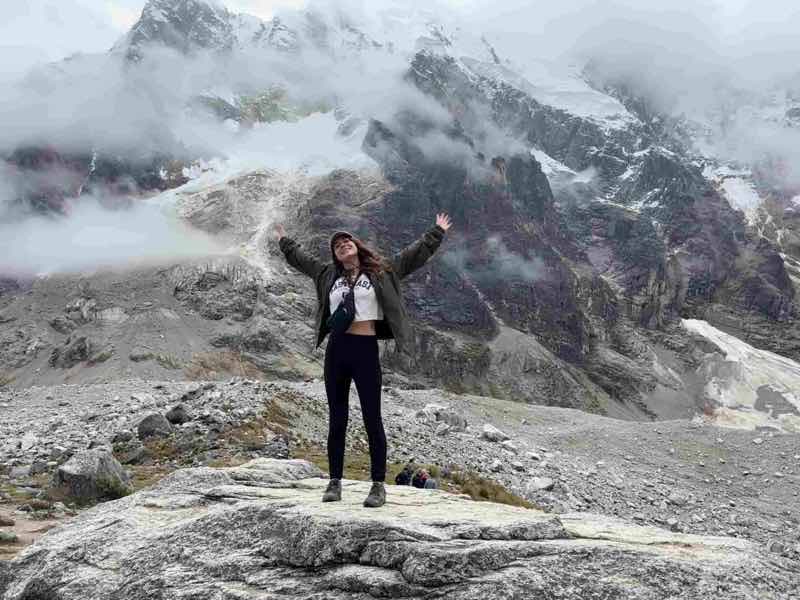
The Salkantay Trek – me at Salkantay Pass
I always knew that I would hike to Machu Picchu. For an avid hiker like me, the train wasn’t going to cut it, but I am also rather indecisive in my travel planning. This gave me a dilemma: How do you hike the Inca Trail, which you have to book six months in advance, and still have the freedom to travel South America one day at a time?
When I set off on my adventure through the Americas, I made the somewhat cowardly decision not to book anything. “I’ll hike the Inca Trail another time,” I told myself, but there was doubt in the back of my mind. What if the rumors about Machu Picchu closing were true? What if I never had the chance to go back to Peru?
Luckily enough for this fickle traveler, a third option presented itself to me one day when I hopped onto a bus from Lima to Huacachina. A British boy in front of me reclined his seat all the way back until he was practically sitting in my lap, and used this as a convenient excuse to start a conversation.
“Wait, you’re not going to Machu Picchu?”
“No, I really want to wait until I can do the Inca Trail, getting the train there feels like a cop-out.”
“Why don’t you do the Salkantay Trek?”
“The what?”
And that was us for the rest of the bus journey.
A few days later my new friend and I found ourselves on one of the best free walking tours I’ve ever done in the White City of Arequipa, but I missed half of it because I was busy texting an erratic travel agent who was arranging my trek from Cusco and buying one of the last remaining tickets to enter Machu Picchu the following week. When he sent me the booking confirmation, I could hardly believe my eyes. It was really happening. I was going to Machu Picchu. Wait, I thought, I’d better get myself to Cusco.
The Salkantay Trek: Pre-Departure
I spent the next three days in Cusco with a surprisingly long checklist, which had me bustling around the city and quickly acclimatizing to the altitude. This included exchanging money (tours usually have to be paid in USD, cash), signing release forms, and picking up equipment (including walking poles, a sleeping bag, and various toiletries and snacks I added to the list myself). Top tip: don’t forget to take your own toilet paper.
I’d recommend three days in Cusco for exactly this: to acclimatize and to make sure you have everything you need for the trek. Your travel agency will give you a list of everything you’ll need to bring.
A duffel bag provided by the agency, which would be transported by porters and by car, held my equipment, toiletries, and a spare pair of clothing. My day pack held snacks, water, emergency supplies, a rain poncho, a head torch, and my phone. These two bags sat at the end of my bed, alongside my trusty hiking shoes (which, unknowingly, were about to embark on their last adventure), my hiking poles, and a neat pile of clothes for the morning.
I hauled my unusually empty backpack down to reception and checked it into storage. This is one of the great things about Cusco: practically every hostel and hotel around will store your bag for free whilst you go galavanting across various Peruvian mountains.
The Salkantay Trek: Leaving Cusco
I woke at 4 am on the first morning of the Salkantay Trek. There was a surprising number of people milling around the hostel, checking their watches, and sipping on coca tea. Most of them quickly disappeared off to Rainbow Mountain as their names were called by guides until just me and one other remained.
His name was Mars, he was Dutch, and he was doing the Salkantay Trek, too. I realized that he was woefully unprepared when he told me that he hoped this trek would be easier than the two-hour Rainbow Mountain hike he’d done a few days before.
Although the Salkantay Trek can be done by anyone with a reasonable level of fitness, it is not for the faint-hearted. You do need to be fit, already acclimated to the altitude in Cusco (because you will climb more than 1,000 meters higher on the trek), and mentally prepared for a tough few days.
Our guide, Raul, was late, and we would soon come to learn that this was quite on-brand for him.
We set off on a two-hour hike to our first base camp at Soraypampa, which was easy, fun, and the last time anyone had phone service for three days. Each of the camps we stayed at had wifi for 10 soles (around $2.60), but I decided to stay off-grid.

The Salkantay Trek – accommodation options
The accommodation you will stay in on the trek is completely up to the tour you book (you can also do this hike without a tour, but I would only recommend that to well-seasoned hikers). I took one of the cheaper options, so we stayed in A-frame cabins that were essentially like tents but made of wood. I had friends who chose more expensive options and stayed in real beds or even glass domes under the stars.
After arriving at base camp we ate, settled into our cabins (Mars and I bunked together, as the only two solo travelers), and prepared for the first sidequest: Humantay Lake.
The Salkantay Trek Day 1: The Soraypampa Trek
The Soraypampa Trek to Humantay Lake is just 4.2 kilometers. 2.1 kilometres up, and 2.1 kilometres back down again. Sounds easy, right? Wrong. It’s actually labeled moderately challenging on All Trails due to the steep incline and altitude. You start at Soraypampa base camp, which is just above 3,800 meters, and reach 4,200 meters within 2 kilometers of walking. If you weren’t sure, that’s steep.
The climb felt endless. Every time we thought we’d reached the top, we’d crest the hill only to find another climb ahead. I gave one of my walking poles to Mars, who hadn’t brought any. He tried not to accept but eventually gave in when he realized how much easier it made the climb. If this is one of your first big hikes you might be tempted not to take hiking poles, but let me assure you they are completely worthwhile.
By the end, we really had to push ourselves to reach Humantay Lake before the clouds rolled in and dulled our view of the precious blue waters.
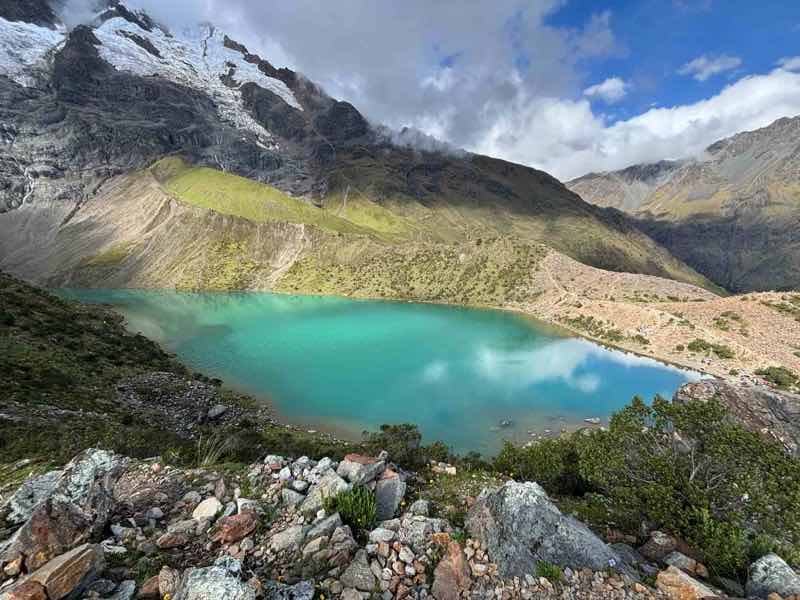
The Salkantay Trek – first side quest Humantay Lake
This is, however, something I love about hiking: the harder it is, the better it feels when you reach the top. The views were spectacular.
There’s another small climb on the other side of the lake, but in all honesty, the best view is right there on the shore. The water of Humantay Lake has an opaque turquoise color, unlike anything I’ve seen before. It is flanked by unforgiving, razor-sharp mountains capped with thick snow. If you listen carefully, the crack of a faraway avalanche will cut through the otherwise silent landscape like a lightning bolt.
Rain came in as we began our descent, which was decidedly miserable. With the promise of an incredible summit behind us and rainwater soaking into our shoes, silence fell over our group until we made it back to base camp.
An endless supply of popcorn and hot chocolate awaited us, which could not have been more welcome as a truly bitter cold descended. At 3,800 meters the chill cuts straight to your bones, and I’d piled on every layer I had before the sun had even gone down. After an early dinner, we retired to our huts, exhausted, and woke before sunrise to continue our quest to the Salkantay Pass.
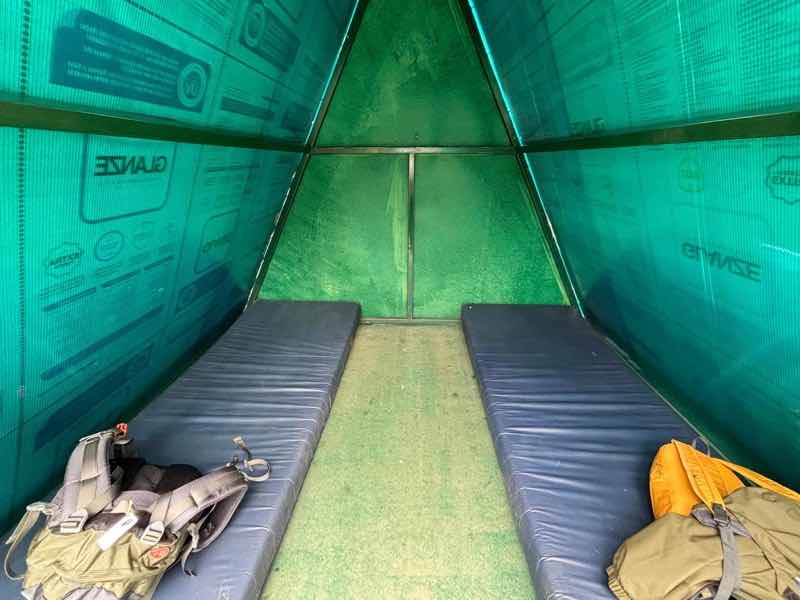
The Salkantay Trek – inside the huts
The Salkantay Trek Day 2: The Salkantay Pass
We were woken by guides delivering hot coca tea to our cabins, which I have to tell you is about the best way to get woken up (even if it was 4.30 am). For those of you who don’t know, coca leaves are a mild stimulant, similar to drinking a strong cup of coffee, that can be consumed as tea, in food, or by chewing the coca leaves. They are a natural remedy for altitude sickness and a staple throughout Peru, particularly in high-altitude regions.
It wasn’t until I climbed out of our hut that I noticed it must have rained all night long. It started to rain again as we left camp and one by one we donned rain ponchos. Mine was comically large but it did the job, covering both me and my backpack all the way down to my shins.
After an hour of head-down, grit-your-teeth hiking through muddy puddles and persistent rain, the blanket of bad weather lifted alongside the sunrise. Light showers came and went as we climbed up towards the Salkantay Pass, but the worst of the rain had gone. The air slowly became thinner as we climbed.
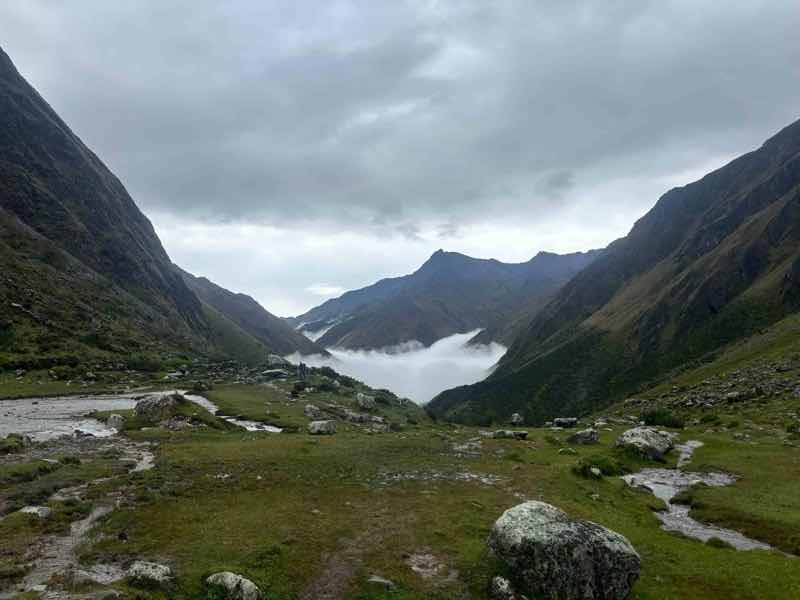
The Salkantay Trek – the fog that chased us to the Salkantay Pass
Hiking at altitude can be disorienting, and not just because you’re starved of oxygen. At altitude you get out of breath so quickly, then return to normal breathing as soon as you stop. It’s difficult to know if you truly need a rest, or if you just can’t catch your breath. Mars and I walked together at a steady pace, taking turns with my walking poles and pausing for regular breaks.
Although the rain had mostly disappeared, a thick fog was chasing us up towards the pass and I knew we had to hurry if we wanted to get a good view of Salkantay mountain. For the second time we were racing against the weather, but that only made for a sweeter reward as we arrived before the fog rolled in.
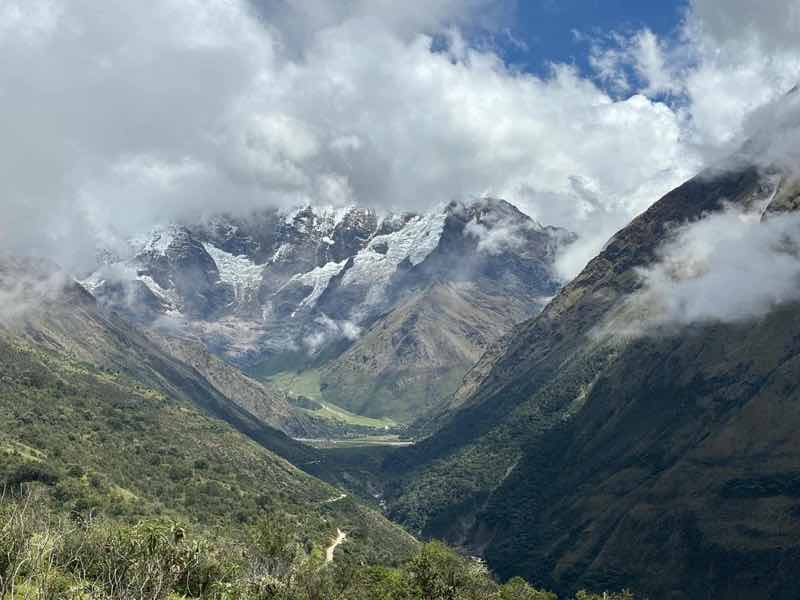
The Salkantay Trek – first views of Salkantay mountain
After another three hours of uphill hiking, it felt incredible to finally arrive at Salkantay Pass. Between two mountains that soared over 6,000 meters each, it was hard to believe that we’d reached 4,650 meters above sea level. We stopped here for a while to take photos and listen to our guide tell stories about local legends of the area.
I felt on top of the world as we plowed onto our lunch spot. We ate mountains of food (no pun intended) as our bodies recovered from the high-altitude trek, but didn’t stop to rest; we still had a long way to go before nightfall. Day two is the longest day of the Salkantay Trek, with around 25 kilometers walked.
We arrived before dark at a slightly larger campsite and the mountains of popcorn and hot chocolate we’d grown accustomed to.
There were other groups besides us here in the very small town of Chaullay, and a small bar across the road. I immediately regretted trying to walk there in flip-flops and socks (a combination I otherwise maintain is legendary) when I got one flip-flop stuck into the mud and had to accept a piggyback ride home from Mars. The beer was worth it, though.
We also had our first and only shower of the hike here. We each paid 10 soles (around $2.60) for soap and hot water, which felt like the ultimate luxury. There were no showers at all at any of the other campsites we stayed at.
After another amazing dinner – all of the food we ate on this trip was great – we socialized for a while and retired early, ready for another 4.30 am wake-up call.
The Salkantay Trek Day 3: The Amazon Rainforest
Chaullay and the rest of the Salkantay Trek is on the very eastern edge of the Amazon Rainforest. While I love to be able to say that I hiked in the Amazon, I don’t imagine it was much like the traditional image most people conjure when I say that. For one, it’s more mountainous than jungle-like. For another, we were still at 2,700 meters and, therefore, rather cold.
My walking boots were old, and soaked through. It didn’t matter what I did to them: stuff them full of newspaper, hang them up during the night, or cover them with plastic bags. They were sodden to their very core and stayed that way for the rest of the hike.
The morning routine was clockwork by now: wake up, coca tea, pack up, eat breakfast, walk.
The trail on day three was supposed to be easy, and the trail itself was. It was almost completely flat, an unsurfaced road carved into the side of an otherwise unspoiled mountain. The river that flowed below, destined to join the Amazon, was high and frothing, overflowing with rainwater and foreshadowing the danger to come.
A couple of hours into the trek we tried some locally grown Peruvian fruit at a rest stop. It was absolutely delicious and we stocked up for the road ahead, expecting an easy day.
It wasn’t long until we hit the first landslide.
This is a story I could tell in great detail, but to save the nerves of any aspiring hikers, I will keep it short. The Salkantay Trek is not dangerous, and accidents like this are rare. Tour guides don’t take hikes during the months when landslides are more likely, and when they do happen, precautions are taken. According to All Trails, a small part of the Salkantay Trek is still closed due to landslides, but a diversion has been created for hikers to complete the trail safely.
We were incredibly unlucky to be on the trail when landslides happened and essentially got trapped in between several on the side of a mountain. We were able to climb out with the help of some insanely brave locals who dug a path through the fallen debris and helped us navigate it as safely as possible.
It was scary, but not something you should worry about happening on your trek.
We arrived at Playa Sahuayaco in time for a late lunch and a tour of their coffee plantation, and in the afternoon we split into two very distinct groups: those who continued hiking on an optional side quest, and those who took the minivan to the thermal baths in Cocalmayo.
I, of course, opted for the thermal baths. It was just what we needed after a stressful day of landslide escaping, and the mineral waters of natural hot springs are great for muscle repair on hikes.

The Salkantay Trek – the trainline from Hidroelectrica to Aguas Calientes
The Salkantay Trek Day 4: Aguas Calientes
On day four of the Salkantay Trek we were due to hike the Llactapata Pass, which has a spectacular view of Machu Picchu, and then take the train Aguas Calientes.
Thanks to the unprecedented rainfall, this part of the hike was called off. I don’t think any of us were too disappointed after the experiences of the previous day; we were just happy that someone had spotted the danger in advance and diverted us around it.
Instead, we basically did everything back-to-front. Instead of hiking to Hidroeléctrica we took a van, and instead of taking the train from Hidroeléctrica to Aguas Calientes, we hiked.
I had a friend who did the original route and hiked the Llactapata Pass. She said it was a long hike and the ascent felt endless, but it was worth it to see the view of Machu Picchu. She spent the night in Llactapata and watched the sunset over the valley; the pictures looked incredible, so if you have the luxury of staying there it comes highly recommended.
This last-minute change meant we had to carry all of our kit along the train track from Hidroeléctrica to Aguas Calientes. My duffel bag only weighed around 7 kilos, but it wasn’t designed for carrying long distances so the strap cut into my skin and had me off-balance. Although it was flat, this was one of my least favorite parts of the hike.
Whilst again, this may not happen on your trip, one thing I did learn throughout this experience is that you have to be open to change with a little side of chaos. Especially with the more budget operators, things don’t run as smoothly as you’d expect in the US or Europe.
We arrived at our hotel in Aguas Calientes utterly exhausted, but the sense of achievement was indescribable. We made it.
I suppose that’s the end of the story when it comes to the Salkantay Trek, which officially finishes in Aguas Calientes. Many more have done what we did next: climb the famous steps to Machu Picchu.

The Salkantay Trek – Machu Picchu
The Salkantay Trek Day 5: Machu Picchu
There are 1,600 steps to the sacred site of Machu Picchu, with an elevation gain of almost 500 meters.
I was quite happy to wake up at 4 am for the last time. Most of our group had tickets to enter Machu Picchu between 6-7, so Raul told us to meet him at the entrance at 6.45 sharp, where he would distribute various tickets and we would all enter together. For the first time on the trip, he would not be hiking with us. He said he would take the bus and meet us at the top, but he did not explain why.
Our group met in the hotel lobby at 4.30 and hiked from Aguas Calientes town to the bottom of the steps to Machu Picchu through pitch-black torrential rain. Our plan was to begin the 1-hour ascent at 5.30 to allow us some contingency time.
We arrived to find… a queue. Raul hadn’t said anything about a queue.
There was a ticket checkpoint nobody had told us about at the beginning of the climb to Machu Picchu. Luckily most of us had a copy of our ticket, but three people were left stranded outside the gate, including Mars. Raul was the only one who had their tickets, and he wasn’t picking up the phone.
The clock was ticking.
We all waited for as long as we could. We called and texted Raul, our travel agencies, and any number we could think of to try and get hold of the missing tickets, but it was too early and nobody answered.
At 5:50, with 1 hour left to walk and 1 hour 10 minutes left until our tickets to Machu Picchu became invalid, we left them behind. Turning away from them to cross over the turbulent river and begin the hike felt like a slow-motion scene they’d make a movie of one day.
It was still pouring rain, and I was devastated for our fellow hikers. How could they have come all this way, only to be let down at the final minute? I can’t imagine how I would have felt in that situation. The mood was low but we had a long way to climb; there was no time to waste.
Somehow, after ten minutes of silently trudging up what was supposed to be the most exciting part of the trip, I felt a tap on my back. Mars! In an amazing twist of fate, the hikers we’d left behind had managed to contact their travel agent and get hold of all three missing Machu Picchu tickets.
Despite feet that had been wet for three days, a severe lack of sleep, aching legs, and blisters on my hands beneath the straps of my walking poles… I was elated.
For some, it was a tough climb, but we got through it together. For me, it wasn’t difficult at all. All I remember is a bubbling sense of excitement. We’re going to Machu Picchu. I was running on pure adrenaline, and the rain, the panic, and the race against the clock only made it more exciting.
We reached the gates of Machu Picchu a few minutes before 6.45, but Raul was nowhere to be seen. He still wasn’t answering our calls. We hung around the entrance until 6:55 when we had no choice but to go through the gates and wait inside.
At 7.30 we were talking about going it alone when somebody spotted Raul’s unmistakable red raincoat approaching the gate. We quickly got the answer to a lot of questions as he approached us. There was alcohol on his breath. His words were slurred.
His eyes were glazed as he took us around Machu Picchu, giggling at wisps of fog in thin air and pointing out totally irrelevant things. He also told us to calm down several times when nobody was panicking, but in the end, none of it mattered. We were at Machu Picchu. We’d been hiking for five days to get here. One of the seven new wonders of the world. The final remnants of the Incan Empire.
Although it was a shame to walk past other tour guides with wads of photographs and animated stories, the real marvel was not what you can read in books but what was right there in front of us.
Whilst the landslides and the drunken tour guide will probably be stories that I tell for years to come, many things will fade with time. The blisters, the wet shoes, the aching calves, the soaking clothes. None of these memories will stay for a lifetime like the moment the clouds lifted and we saw Machu Picchu for the first time.
The Salkantay Trek Day 5: Returning to Cusco
Our drunken tour guide abandoned us halfway around Machu Picchu (which was just as well, he really looked like he needed a nap). We showed ourselves the rest of the way around, scrolling through Wikipedia for clues, until it was time to head back to Aguas Calientes.
We descended back into Aguas Calientes and ate the biggest pizza I have ever seen in the place next door to our hotel. Say what you want about trying the local cuisine, I’ve never enjoyed a pizza more in my life.
Everyone had tickets for different trains, so I said my goodbyes and headed to the station alone. The train ride back to Cusco from Aguas Calientes is supposed to be picturesque, but I found it quite underwhelming. How could the countryside possibly compete with what we’d seen over the last five days?
I daydreamed the whole way back to Cusco and dumped my hiking shoes straight in the bin. I saved the laces as my lucky charm, given that I’d had the same pair since my very first solo trip and they’d covered more mileage than my first Toyota Yaris. Before I’d even showered I dug out my pink flip-flops and squeaked my way to the North Face shop in Cusco town, with cold toes and a mission to be much better prepared for my next adventure.
Leave a Reply
Tags: article, cusco, hiking, machu picchu, peru

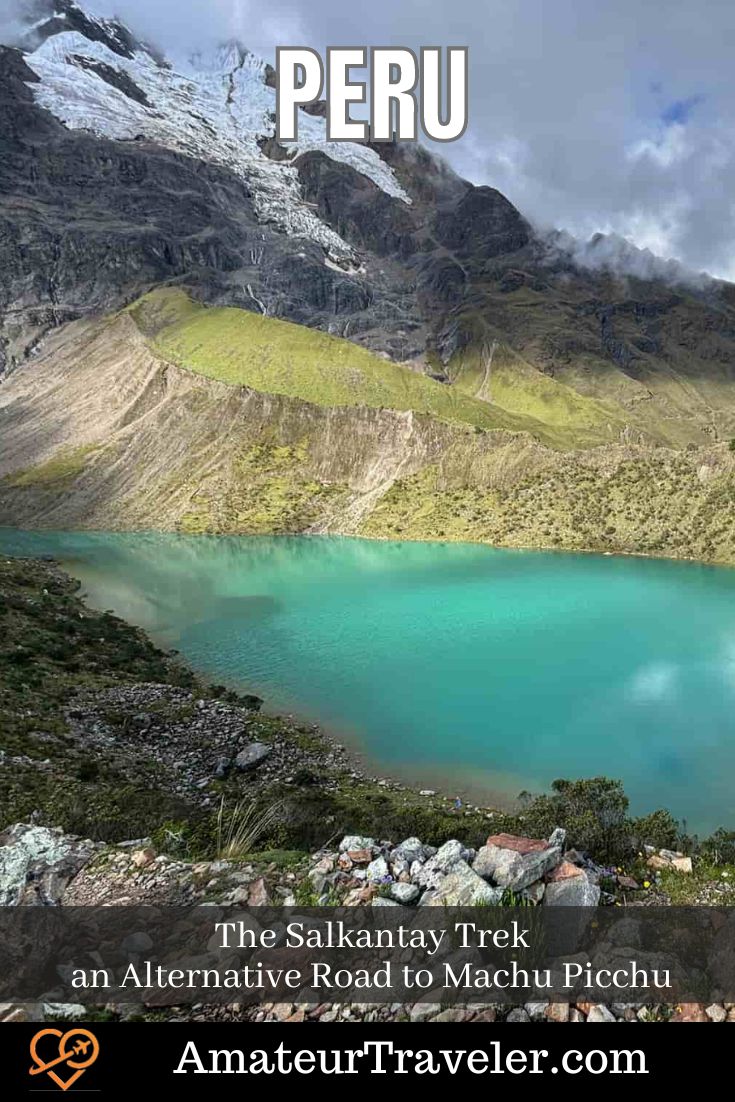
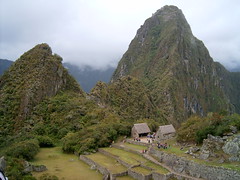 Heading to Machu Picchu? Why You Should Explore the Ruins Around Cusco First
Heading to Machu Picchu? Why You Should Explore the Ruins Around Cusco First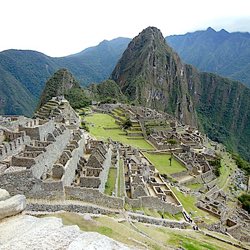 Planning a Trip to Machu Picchu, Peru For First Timers
Planning a Trip to Machu Picchu, Peru For First Timers Could Marcahuamachuco, Peru Really Rival Machu Picchu?
Could Marcahuamachuco, Peru Really Rival Machu Picchu?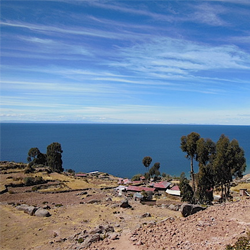 Lake Titicaca Travel – Why Lake Titicaca Was Better than Machu Picchu
Lake Titicaca Travel – Why Lake Titicaca Was Better than Machu Picchu
